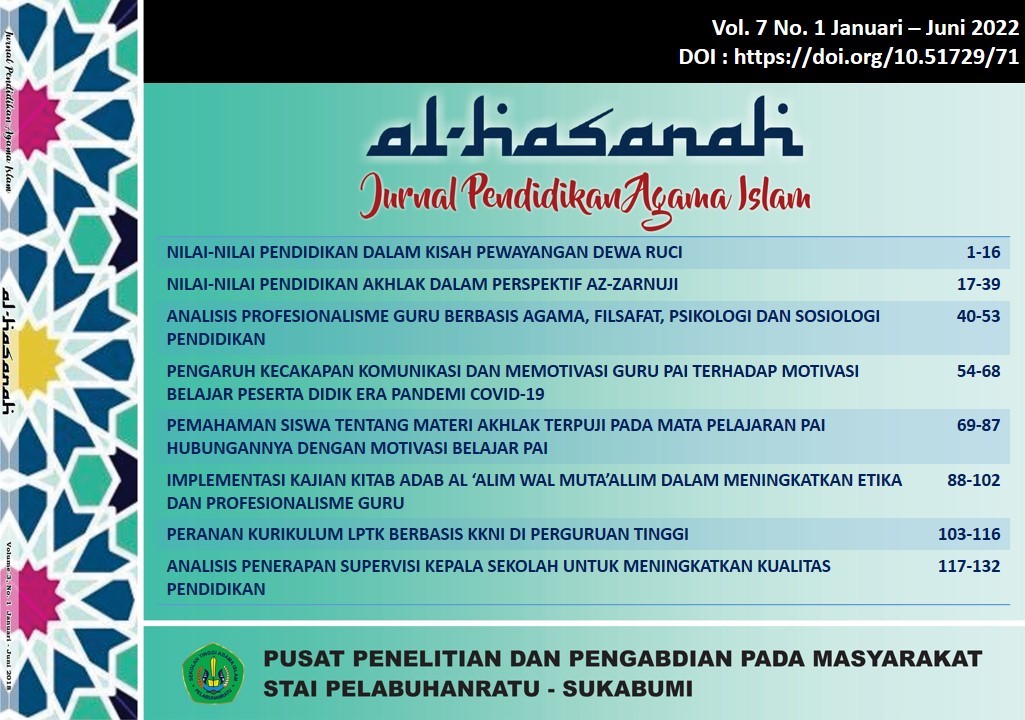NILAI-NILAI PENDIDIKAN DALAM KISAH PEWAYANGAN DEWA RUCI
DOI:
https://doi.org/10.51729/7150Keywords:
shadow puppets, lakon Dewa Ruci, educational valuesAbstract
Wayang kulit is part of the form of local Indonesian culture, which has existed and survived since the time of the ancestors. Puppet shows are not only intended for entertainment, but also contain noble values that can be realized in every aspect of life in the world. The art of wayang kulit has developed as a means of inculcating the value of life which is quite effective in achieving educational goals. In this day and age, there are many educational problems in Indonesia, including the education system that is not good, the quality of education is not evenly distributed, the facilities and infrastructure are very worrying, the quality of education personnel (teachers) is not paid attention to, the curriculum is always patchy. In the wayang purwa story, Dewa Ruci's play has something to do with educational values that can be applied today, which tells of the obedience of a student named Raden Wijasena, who is very persistent in seeking knowledge. The purpose of this study is to describe the educational values contained in the Dewa Ruci puppet story. The story can be used as a contribution to education in Indonesia. The method used is literature study. Through this method, the problems contained in this paper can be solved. The educational values contained in the play include: the importance of the value of perseverance, tenacity, belief and trust in one's choice of knowledge (art), professions, educational interventions and teachers are only facilitators and means in achieving educational goals.
Downloads
References
Arifin, F. (2013). Wayang Kulit sebagai Media Pendidikan Budi Pekerti. Jantra: Jurnal Sejarah Dan Budaya, Vol.8, 79.
Azizah, N. (2006). Perilaku Moral dan Religiusitas Siswa Berlatar Belakang Pendidikan Umum dan Agama. Jurnal Psikologi, Vol.33, 3.
Dui Nugraha, H. (2015). Diplomasi Pemerintah Indonesia Untuk Meresmikan Wayang Kulit Sebagai Warisan Budaya Indonesia terhadap UNESCO. EJournal Ilmu Hubungan Internasional, Vol.3, 1283.
Guritno, P. (1988). Wayang, Kebudayaan Indonesia dan Pancasila. UI Press.
Haryanto. (1992). Bayang-Bayang Adiluhung. Dahara Prize.
Herlyana, E. (2013). Pagelaran Wayang Purwa sebagai Media Penanaman Nilai Religius Islam pada Masyarakat Jawa. THAQAFIYYAT: Jurnal Bahasa, 128.
Isnaniah, S. (2010). Dewa Ruci: Sebuah Alternatif Sistem Pendidikan. LiNGUA: Jurnal Ilmu Bahasa Dan Sastra, Vol.5, 44.
Isnaniah, S. (2011). Dewa Ruci: Sebuah Alternatif Sistem Pendidikan. LiNGUA: Jurnal Ilmu Bahasa Dan Sastra, 5(1). https://doi.org/10.18860/ling.v5i1.612
J. Moleong, L. (1990). Metode Penelitian Kualitatif. : PT. Remaja Rosdakarya, 1990.
Marsaid. (2016). Islam dan Kebudayaan: Wayang Sebagai Media Pendidikan Islam di Nusantara. Kontemplasi: Jurnal Ilmu-Ilmu Ushuluddin 4, 113.
Murtiyoso, B. (2004). Pertumbuhan dan Perkembangan Seni Pertunjukan Wayang. Etnika Surakarta.
purwanto, S. (2018). Pendidikan Nilai Dalam Pagelaran Wayang Kulit. TA’ALLUM: Jurnal Pendidikan Islam, Vol.06, 1–30.
Salam, S. (1960). Sekitar Wali Sanga. Menara Kudus.
Setiawan, E. (2017). Makna Filosofi Wayang Purwa Dalam Lakon Dewa Ruci. Kontemplasi: Jurnal Ilmu-Ilmu Ushuluddin 4, Vol.5, 403–404.
Siswaharsoyo. (1952). Serat Dewaruci. Percetakan Persatuan.
Soeprapto, S. (2009). Transformasi Nilai-Nilai dan Alam Pemikiran Wayang Bagi Masa Depan Jati Diri Bangsa Indonesia. Jurnal Filsafat, Vol.19, 147–64.
Soetarno, S. S. (2007). Estetika Pedalangan. CV. Adji Jl.Yos Sudarsono No.49 Surakarta.
Supanggah, R. (1996). Komposisi (baru) Karawitan (Jurusan Karawitan Fakultas Seni Pertunjukan (ed.)).
Sutomo, I. (2014). Modification of Character Education into Akhlaq Education for the Global Community Life. Indonesian Journal of Islam and Muslim Societies, Vol.4, 294.
Yock Fang, L. (2011). Sejarah Kesusastraan Melayu Klasik, ed. oleh Riris K. Toha-Sarumpaet. Yayasan Pustaka Obor Indonesia.
Downloads
Published
How to Cite
Issue
Section
License
Authors who publish with this journal agree to the following terms:
- Authors retain copyright and grant the journal right of first publication with the work simultaneously licensed under a Creative Commons Attribution 4.0 International License. that allows others to share the work with an acknowledgement of the work's authorship and initial publication in this journal.
- Authors are able to enter into separate, additional contractual arrangements for the non-exclusive distribution of the journal's published version of the work (e.g., post it to an institutional repository or publish it in a book), with an acknowledgement of its initial publication in this journal.
- Authors are permitted and encouraged to post their work online (e.g., in institutional repositories or on their website) prior to and during the submission process, as it can lead to productive exchanges, as well as earlier and greater citation of published work.




















